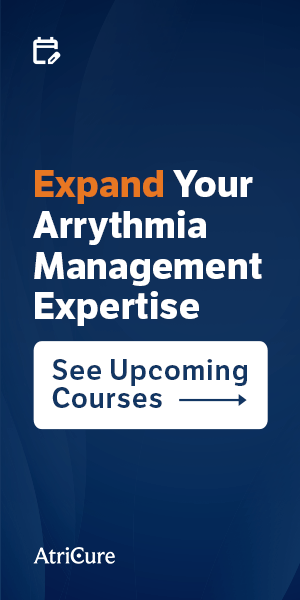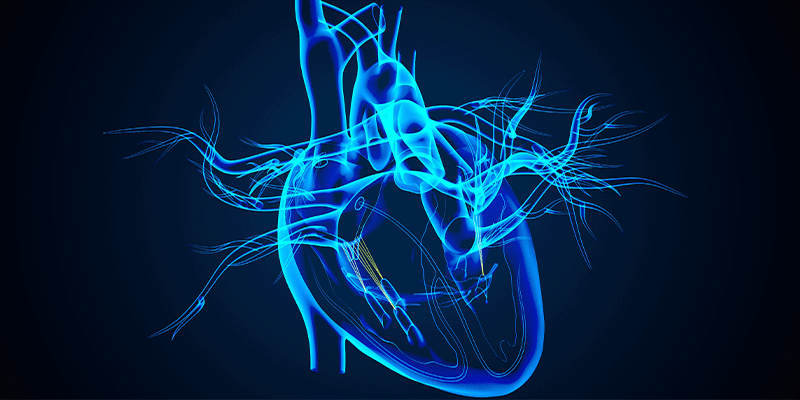The Hidden Threat: Atrial Cardiomyopathy

Understanding the progressive damage that sets the stage for atrial fibrillation
The Heart's Silent Warning System
What if the heart could warn us about atrial fibrillation (Afib) before it actually develops? What if there were measurable signs of the damage that creates the perfect environment for Afib—months or even years before the first erratic or irregular heartbeat?
Fortunately there are. And this condition has a name: Atrial Cardiomyopathy (ACM).
In short, ACM is a sick atrium, developing and exhibiting all the characteristics of Afib—even before Afib exists. 1 Most Afib patients have an established form ACM, which appears to be an important marker for the development of Afib in the future. 2
What Exactly Is Atrial Cardiomyopathy?
ACM is any complex of structural, architectural, contractile, or electrophysiological changes affecting the atria with the potential to produce clinically-relevant manifestations. 3 In short, it’s damage that alters cellular structure or causes cell death.
Because atrial cells react quickly and extensively to pathological stimuli, they are susceptible to a broad range of genetic influences. 2 This makes the atria particularly vulnerable to the cascading effects of cardiovascular risk factors.
ACM doesn't just happen on its own—it's driven by comorbidities such as hypertension, heart failure, and valvular disease, and has shown independent associations with stroke. 4 That’s important because ACM can increase stroke risk even before Afib develops.
The Three Pillars of Atrial Damage
Understanding how ACM develops requires looking at the environmental factors that create a progressively damaging situation in the heart:
Stress
Oxidative Stress at the Cellular Level
Proper cell function depends on a delicate balance between antioxidants and reactive oxygen species (ROS). When this balance is persistently disrupted, excessive ROS damage cellular components, including mitochondria, affecting cell function and ultimately leading to cell death.
Systemic Stress Factors
Multiple Afib risk factors are closely associated with ROS formation, which is one of the main components of atrial remodeling: 2
- Hypertension and myocardial infarction
- Obesity and metabolic disorders
- Persistent tachycardia and valvular pathology
- Excess alcohol and stimulant use
- Smoking and high-fat diet
- Chemotherapy and coronary artery disease
The 2023 ACC/AHA/ACCP/HRS Guideline for the Diagnosis and Management of Atrial Fibrillation emphasizes managing obesity, weight loss, physical activity, smoking cessation, alcohol moderation, and hypertension precisely because these factors generate the increased ROS that leads to cellular changes resulting in inflammation and fibrosis. 19, 2
Stretch
Mechanical Overload
Anything that creates pressure or volume overload of the atria causes elongation of the cardiomyocytes, resulting in increased atrial stretch. 6 As atrial size increases, so does the risk of stroke and persistent reentry circuits.
Changes that promote Afib and atrial remodeling—even before the first episode of Afib—occur in atria from patients with heart failure, hypertension, and mitral valve disease. 6The Cascade Effect
Mechanical stretch, typically associated with pressure and/or volume overload, is believed to be an important contributor to cardiac fibrosis development. For example, left diastolic dysfunction or mitral valve disease can cause the left atrium to experience chronic sustained elevated pressure. Chronic stretch leads to left atrial dilatation, with heterogeneous remodeling of atrial architecture including myocyte hypertrophy, fibrosis, and gap junction remodeling. 7
Scar: The Permanent Damage
Fibrosis Formation
Another sign of structural remodeling and an important substrate of Afib is fibrosis—the formation of excessive extracellular matrix consisting mainly of fibroblasts and elastic and collagen fibers. 6
Areas of scar are commonly located on the posterior atrial wall and around the pulmonary veins 8 due to increased tension on pericardial reflections that anchor the posterior heart to the chest wall.
Left atrial scarring can serve as a substrate for slow conduction and intra-atrial reentry, and is associated with a lower ejection fraction, larger left atrium size, and increased inflammatory markers. 9
Recognizing the Warning Signs: How to Detect ACM
Since histological examination requires an invasive left atrial biopsy that's only an option for a small number of patients, 11 cardiologists have identified key mechanisms to detect ACM development:
- Fibrosis
- Electrical dysfunction
- Mechanical dysfunction 10
Important Clinical Markers
Markers of ACM have been independently associated with incident stroke, 12 making early detection critical for prevention.
In a current study, patients enrolled in the LeAAPS trial have risk factors for Afib and ischemic stroke, which include the following ACM markers:
CHA2DS2-VASc Score
This score is traditionally used to stratify stroke risk in Afib patients, but research shows it predicts mortality in cardiac patients and Afib recurrence even in those without current Afib. 14
CHA2DS2-VASc Scoring System: 13- Congestive heart failure (1 point)
- Hypertension (1 point)
- Age ≥75 years (2 points)
- Diabetes mellitus (1 point)
- Stroke/TIA/Thromboembolism history (2 points)
- Vascular disease (1 point)
- Age 65–74 years (1 point)
- Sex category – female (1 point)
Left Atrial Enlargement (LAE): The Structural Warning
LAE can result from intrinsic atrial abnormality, altered workload, or compensation. 5
Additionally, LAE has been independently associated with an increased risk of ischemic stroke in the absence of Afib. 4 A meta-analysis of five prospective cohort studies indicates that for each increase of 1 cm in left atrial diameter, the odds of stroke were increased by 24%. 16NT-proBNP: The Biochemical Marker
This neurohormone has shown a strong correlation with echocardiographic parameters of left atrial remodeling and dysfunction.11
It serves as an indicator of the cardiac stress and volume overload that characterize ACM. 17
The Big Picture
ACM markers are independently associated with increased stroke risk. 1 This means ACM represents a "perfect storm" where:
- Pre-Afib stroke risk increases due to atrial dysfunction
- Afib development becomes more likely due to structural changes
- Treatment becomes more challenging once Afib is established
What’s the Opportunity for Patients and Physicians to Take Action Together?
For Patients: Know the Risk Factors
If you have multiple cardiovascular risk factors—hypertension, diabetes, obesity, sleep apnea, or a family history of heart disease—ask your doctor about:
- Aggressive management of modifiable risk factors
- Comprehensive cardiac imaging to assess left atrial size and function
- CHA2DS2-VASc score calculation even if you don't have Afib
- Biomarker testing including NT-proBNP levels
For Healthcare Providers: Expand the Conversation
ACM challenges us to think beyond traditional Afib management:
- Screen for ACM markers in high-risk patients
- Implement comprehensive risk factor modification programs
- Monitor closely for Afib development in patients with established ACM
- Consider stroke prevention strategies in patients with significant ACM markers, even without Afib
Looking Ahead
ACM represents both a warning and an opportunity. It's the heart's way of signaling that changes are occurring before they become irreversible. By recognizing and addressing it early, we can potentially prevent Afib, reduce stroke risk, and preserve quality of life.
What’s the most important takeaway? Don't wait for Afib to develop. Act on the warning signs of ACM.
Understanding that the atria can be "sick" before they're obviously irregular gives patients and physicians a chance to take preventive action when it can still make a difference.



